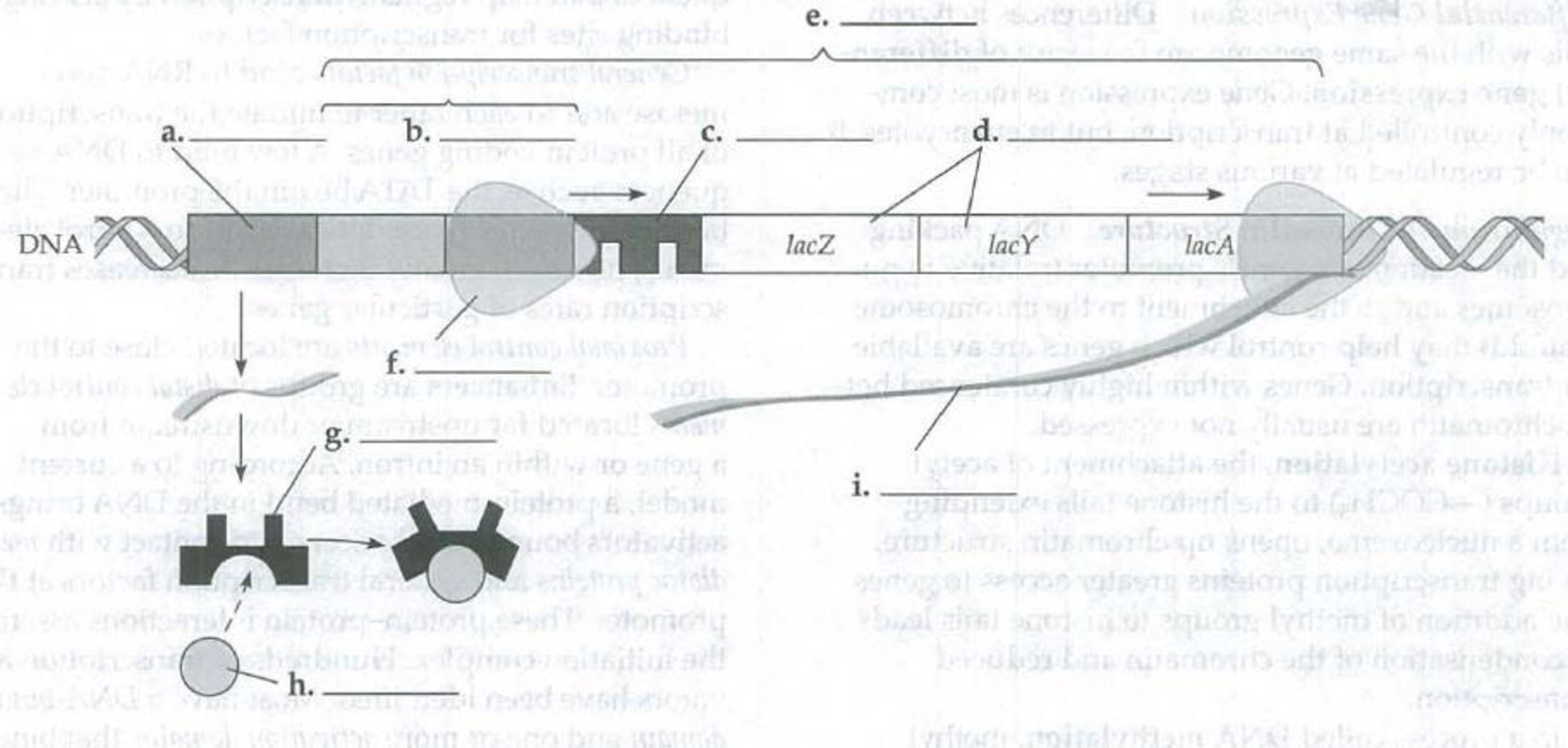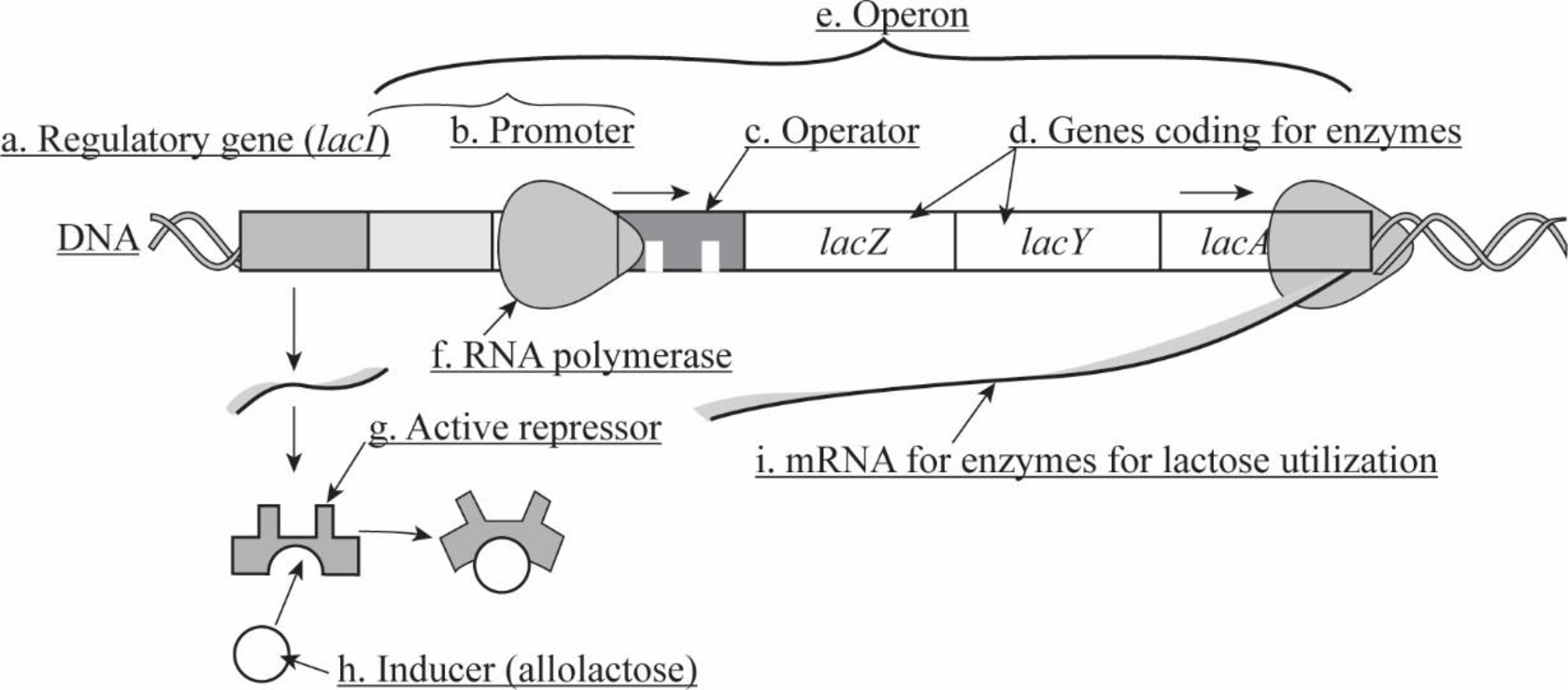
Concept explainers
In the following diagram of the lac operon, an inducible operon, identify components a through i.

To identify: The components of an inducible operon, the lac operon.
Introduction: An operon is the functioning part of deoxyribonucleic acid (DNA). Each operon consists of a cluster of functionally related genes that share a single promoter and controlled by a shared operator. Lac operon is an inducible operon that controls the lactose metabolism in Escherichia coli and many other enteric bacteria.
Answer to Problem 1IQ
Pictorial representation: The components of lac operon are labeled in Fig.1.

Fig.1: Lac operon
Explanation of Solution
Lac operon is a group of genes with a single promoter. The genes in the lac operon encode proteins that allow a transport and metabolism of lactose in Escherichia coli.
- Regulatory gene (lacI): Regulatory gene controls the expression of other genes. The lac regulatory gene (lacI) codes for a repressor protein that can bind to the operator of the lac operon.
- Promoter: Promoter is the region adjacent to the operator in the lac operon, where the RNA polymerase binds to initiate a transcription of lactose genes. Promoter region switches on or off the gene expression through protein binding.
- Operator: Operator is the region that lies partially within the promoter in the lac operon. Operator region interacts with the regulatory protein that controls the transcription of the operon.
- Genes coding for enzymes: The lac operon consists of three genes such as lacZ, lacY, and lacA. lacZ gene transcribes as a single mRNA sequence. The lacZ gene encodes an enzyme β-galactosidase, lacY gene encodes an enzyme permease, and the lacA gene encodes trans-acetylase enzyme.
- Operon: Operon is the functional part of a DNA that consists of a group of functionally related genes regulated by a shared operator.
- RNA polymerase: RNA polymerase is an enzyme that synthesizes RNA and catalyzes the initiation and elongation of RNA using a process called transcription. In lac operon, RNA polymerase binds to the promoter region to initiate transcription.
- Active repressor: The activity of repressor (allosteric protein) may be determined by the presence or absence of the co-repressor. The repressor protein is produced by the regulatory gene and is activated by the association of a co-repressor. The activated repressor binds to the operator region, and it inhibits the transcription of lac operon genes.
- Inducer (allolactose): Inducer is allolactose, an isomer of lactose, which triggers or induces transcription. The inducer binds to and inactivates the repressor protein to induce the transcription of operon.
- mRNA for enzymes for lactose utilization: The genes of lac operon transcribe a single mRNA that encodes enzymes. The lacZ gene encodes an enzyme β-galactosidase, lacY gene encodes an enzyme permease, and the lacA gene encodes trans-acetylase enzyme for lactose utilization in Escherichia coli.
Want to see more full solutions like this?
Chapter 18 Solutions
Study Guide for Campbell Biology
Additional Science Textbook Solutions
Biological Science (6th Edition)
Physical Science
Genetics: From Genes to Genomes
Campbell Essential Biology (7th Edition)
- Pleiotropic genes are genes that (blank) Cause a swapping of organs/structures, are the result of duplicated sets of chromosomes, never produce protein products, and have more than one purpose/functionarrow_forwardA loss of function mutation in Pitx1 enhancers can cause (blank) Removal of Pitx1 exons and growth of ectopic hindlimbs, growth of extra ectopic forelimbs, loss of forelimb specification and development, and loss of hindlimb specification and developmentarrow_forwardHox1a most likely contributes to (blank) patterning in the developing embryo? Ventral, posterior, limb or anteriorarrow_forward
- Select all of the following that can help establish Hox gene expression boundaries (things that affect Hox and not things that Hox affects). Retinoic acid, anterior/posterior axis, fibroblast growth factors, vagal neural crest, and enhancersarrow_forwardEctopic expression of Hox often results in (blank) phenotypes. (Blank) transformations are characterized by the replacement of one body part/structure with another. Hoxeotic, homealoneotic, joexotic, or homeoticarrow_forwardWhat's the difference when drawing omega-6 and omega-3?arrow_forward
- . Consider a base substitution mutation that occurred in a DNA sequence that resulted in a change in the encoded protein from the amino acid glutamic acid to aspartic acid. Normally the glutamic acid amino acid is located on the outside of the soluble protein but not near an active site. O-H¨ A. What type of mutation occurred? O-H B. What 2 types of chemical bonds are found in the R-groups of each amino acid? The R groups are shaded. CH2 CH2 CH2 H2N-C-COOH H2N-C-COOH 1 H Glutamic acid H Aspartic acid C. What 2 types of bonds could each R-group of each of these amino acids form with other molecules? D. Consider the chemical properties of the two amino acids and the location of the amino acid in the protein. Explain what effect this mutation will have on this protein's function and why.arrow_forwardengineered constructs that consist of hollow fibers are acting as synthetic capillaries, around which cells have been loaded. The cellular space around a single fiber can be modeled as if it were a Krogh tissue cylinder. Each fiber has an outside “capillary” radius of 100 µm and the “tissue” radius can be taken as 200 µm. The following values apply to the device:R0 = 20 µM/secaO2 = 1.35 µM/mmHgDO2,T = 1.67 x 10-5 cm2/secPO2,m = 4 x 10-3 cm/secInstead of blood inside the fibers, the oxygen transport and tissue consumption are being investigated by usingan aqueous solution saturated with pure oxygen. As a result, there is no mass transfer resistance in the synthetic“capillary”, only that due to the membrane itself. Rather than accounting for pO2 variations along the length ofthe fiber, use an average value in the “capillary” of 130 mmHg.Is the tissue fully oxygenated?arrow_forwardMolecular Biology Please help with question. thank you You are studying the expression of the lac operon. You have isolated mutants as described below. In the presence of glucose, explain/describe what would happen, for each mutant, to the expression of the lac operon when you add lactose AND what would happen when the bacteria has used up all of the lactose (if the mutant is able to use lactose).5. Mutations in the lac operator that strengthen the binding of the lac repressor 200 fold 6. Mutations in the promoter that prevent binding of RNA polymerase 7. Mutations in CRP/CAP protein that prevent binding of cAMP8. Mutations in sigma factor that prevent binding of sigma to core RNA polymerasearrow_forward
- Molecular Biology Please help and there is an attached image. Thank you. A bacteria has a gene whose protein/enzyme product is involved with the synthesis of a lipid necessary for the synthesis of the cell membrane. Expression of this gene requires the binding of a protein (called ACT) to a control sequence (called INC) next to the promoter. A. Is the expression/regulation of this gene an example of induction or repression?Please explain:B. Is this expression/regulation an example of positive or negative control?C. When the lipid is supplied in the media, the expression of the enzyme is turned off.Describe one likely mechanism for how this “turn off” is accomplished.arrow_forwardMolecular Biology Please help. Thank you. Discuss/define the following:(a) poly A polymerase (b) trans-splicing (c) operonarrow_forwardMolecular Biology Please help with question. Thank you in advance. Discuss, compare and contrast the structure of promoters inprokaryotes and eukaryotes.arrow_forward
 Biology (MindTap Course List)BiologyISBN:9781337392938Author:Eldra Solomon, Charles Martin, Diana W. Martin, Linda R. BergPublisher:Cengage Learning
Biology (MindTap Course List)BiologyISBN:9781337392938Author:Eldra Solomon, Charles Martin, Diana W. Martin, Linda R. BergPublisher:Cengage Learning BiochemistryBiochemistryISBN:9781305577206Author:Reginald H. Garrett, Charles M. GrishamPublisher:Cengage Learning
BiochemistryBiochemistryISBN:9781305577206Author:Reginald H. Garrett, Charles M. GrishamPublisher:Cengage Learning Biology: The Dynamic Science (MindTap Course List)BiologyISBN:9781305389892Author:Peter J. Russell, Paul E. Hertz, Beverly McMillanPublisher:Cengage Learning
Biology: The Dynamic Science (MindTap Course List)BiologyISBN:9781305389892Author:Peter J. Russell, Paul E. Hertz, Beverly McMillanPublisher:Cengage Learning Biology 2eBiologyISBN:9781947172517Author:Matthew Douglas, Jung Choi, Mary Ann ClarkPublisher:OpenStax
Biology 2eBiologyISBN:9781947172517Author:Matthew Douglas, Jung Choi, Mary Ann ClarkPublisher:OpenStax Biology Today and Tomorrow without Physiology (Mi...BiologyISBN:9781305117396Author:Cecie Starr, Christine Evers, Lisa StarrPublisher:Cengage Learning
Biology Today and Tomorrow without Physiology (Mi...BiologyISBN:9781305117396Author:Cecie Starr, Christine Evers, Lisa StarrPublisher:Cengage Learning Human Heredity: Principles and Issues (MindTap Co...BiologyISBN:9781305251052Author:Michael CummingsPublisher:Cengage Learning
Human Heredity: Principles and Issues (MindTap Co...BiologyISBN:9781305251052Author:Michael CummingsPublisher:Cengage Learning





